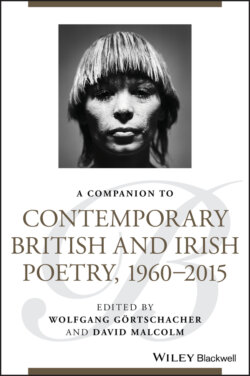Читать книгу A Companion to Contemporary British and Irish Poetry, 1960 - 2015 - Группа авторов - Страница 61
Introduction
ОглавлениеWhat is this text we see before us? This might be a play where two “Kissers” give instructions or narrate their actions during an aerobic sex scene. But, how will the actors perform the “( ( (”? Perhaps the brackets act as instructions to pause, like musical notation; or perhaps the punctuation is a mimetic representation of the rhythms of a sex act. But, if punctuation is mimetically representing action, then this text is one requiring reading on the page to interpret it as such. While the opening section describes action, the end of the main section is more conceptual, involving a reflection on how “perception” can be “cultivated by unexpected finds.” Our perception of the p of textual expressivity is certainly cultivated when experiencing this text. The typographic oddities here are “unexpected,” as are the small, italicized notes to the right of the page, which contribute to the text's self‐reflective tone. But even these complicate things and we notice that, minus the date, the second is a slightly differently arranged version of the first, with “suddenly” curiously emphasized despite its subordination in parenthesis. Suddenly, nothing becomes clear. This writer, we feel, is taking a theme of “the question of / writing,” as she puts it, to its extreme. This is a text in which an ostensible erotic act is interrupted by all sorts of textual play, self‐reflection, and typographic expressivity; it is awkward and disturbing and almost impossible to satisfactorily interpret, let alone categorize.
Caroline Bergvall's poem, “In Situ,” appears in Iain Sinclair's 1996 anthology, Conductors of Chaos. Bergvall is certainly the conductor of a textual chaos, and the name of the anthology very deliberately situates itself (and the poems therein) as representative of poets who court linguistic disorder. Formally, then, Bergvall's poem announces itself as experimentally extreme and willfully challenging. Indeed, as Sinclair (1996, xvii) concedes, many of the poems he selects are difficult: “The work I value is that which seems most remote, alienated, fractured. I don't claim to understand it but I like having it around.” Anticipating a reader's incomprehension, Sinclair continues:
If these things are “difficult,” they have earned that right. Why should they be easy? Why should they not reflect some measure of the complexity of the climate in which they exist? Why should we not be prepared to make an effort, to break sweat, in hope of high return? There's no key, no Masonic password; take the sequences gently, a line at a time. Treat the page as a block, sound it for submerged sonic effects. Suspend conditioned reflexes.
Sinclair favors difficulties and ones representative of social, cultural, and political complexes. A reader should expect to make an effort, not to simply passively consume. Sinclair's comments provide an interpretive context for Bergvall's poem: we must be patient, “[s]uspend conditioned reflexes,” and interpret “a line at a time.” Conductors of Chaos perhaps defines a type of genre that we might call complex, difficult, or conditioned reflex suspending. There are ways of containing “In Situ”: its subject might make it erotica; it displays aspects of concrete or visual poetry; its multiple registers and typographic excesses are modernist, while its self‐reflection and irony make it postmodern. In the end though, despite all these designations, the poem defeats only the most general of categories. “In Situ” illustrates the difficulty of classification and the fact that genre may be unable to account for the styles of particular poems.
The most interesting contemporary poetry is awkward to classify; indeed, its awkwardness is often produced by its esthetic, cultural, and political aims. Alongside an examination of attempts to designate genres in contemporary British and Irish poetry, this chapter will also assess why certain poems resist classification. A consideration of genre theory in relation to recent debates surrounding the lyric will be followed by a sketch of what I shall call two “Urtext‐species” of contemporary poetry. With the help of a recent study of contemporary British poetry by Fiona Sampson (2012), the last, brief section of this chapter will sketch and test some possible subspecies of contemporary poetry. As Neil Corcoran (2007, 2) observes, attempting to get to grips with genres is part of the “persistent inquiry—on what is sometimes still virtually a field of battle—into the applicability of the terms “modern,” “Modernist,” and “postmodern” as ways of understanding the poetry of the twentieth [and twenty‐first] centur[ies].”
